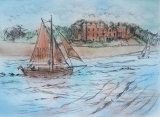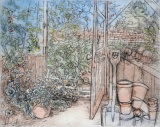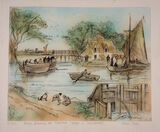Etchings by Anne Rea
Here I am showing my recent etchings, three drypoint etchings and one etching and aquatint.
I am often asked how an etching is produced so here goes.
The copper or zinc plate is covered with a sticky ground of resin. The artist draws on the surface of the metal plate, creating tiny lines and grooves until the drawing is completed.
The plate is then put in an acid bath and the acid bites into the lines and grooves, downwards and sideways.
Drypoint etching involves drawing directly into the surface of the plate with a metal stylus.
The plate is removed from the acid and the resin ground wiped off. The plate is heated and printing ink is then rolled or dabbed on to it. The surface is gently wiped with muslin scrim and then the palm of the hand, until the etched lines are filled with ink.
The plate is then positioned on an etching press and a piece of damp etching paper is placed over it. As the plate and paper are pressed together by the heavy rollers, the paper picks up the ink in the etched lines and the reverse image appears on the paper.
I am often asked how an etching is produced so here goes.
The copper or zinc plate is covered with a sticky ground of resin. The artist draws on the surface of the metal plate, creating tiny lines and grooves until the drawing is completed.
The plate is then put in an acid bath and the acid bites into the lines and grooves, downwards and sideways.
Drypoint etching involves drawing directly into the surface of the plate with a metal stylus.
The plate is removed from the acid and the resin ground wiped off. The plate is heated and printing ink is then rolled or dabbed on to it. The surface is gently wiped with muslin scrim and then the palm of the hand, until the etched lines are filled with ink.
The plate is then positioned on an etching press and a piece of damp etching paper is placed over it. As the plate and paper are pressed together by the heavy rollers, the paper picks up the ink in the etched lines and the reverse image appears on the paper.






